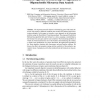Free Online Productivity Tools
i2Speak
i2Symbol
i2OCR
iTex2Img
iWeb2Print
iWeb2Shot
i2Type
iPdf2Split
iPdf2Merge
i2Bopomofo
i2Arabic
i2Style
i2Image
i2PDF
iLatex2Rtf
Sci2ools
CMSB
2006
Springer
2006
Springer
Possibilistic Approach to Biclustering: An Application to Oligonucleotide Microarray Data Analysis
Abstract. The important research objective of identifying genes with similar behavior with respect to different conditions has recently been tackled with biclustering techniques. In this paper we introduce a new approach to the biclustering problem using the Possibilistic Clustering paradigm. The proposed Possibilistic Biclustering algorithm finds one bicluster at a time, assigning a membership to the bicluster for each gene and for each condition. The biclustering problem, in which one would maximize the size of the bicluster and minimizing the residual, is faced as the optimization of a proper functional. We applied the algorithm to the Yeast database, obtaining fast convergence and good quality solutions. We discuss the effects of parameter tuning and the sensitivity of the method to parameter values. Comparisons with other methods from the literature are also presented.
Applied Computing | Biclustering Problem | CMSB 2006 | Possibilistic Biclustering Algorithm | Possibilistic Clustering Paradigm |
| Added | 20 Aug 2010 |
| Updated | 20 Aug 2010 |
| Type | Conference |
| Year | 2006 |
| Where | CMSB |
| Authors | Maurizio Filippone, Francesco Masulli, Stefano Rovetta, Sushmita Mitra, Haider Banka |
Comments (0)

